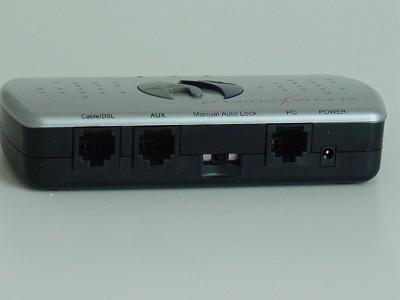| AlphaShield Personal Hardware Firewall |

|
|
One fact that we would like to be clear on is that the AlphaShield is not a NAT (Network Address Translation) router. This means that it does not provide internet connection sharing. Instead it uses three technologies to work its internet security called AlphaGAP, IP Stealth and RPA (Real-time Packet Authorization). AlphaGap just refers to the units ability to completely stop data flow between the internet and host computer, just as if you physically disconnected your computer from your broadband modem by pulling the ethernet cable from it.
IP Stealth means that AlphaShield will discard any ICMP messages it receives from pings or traceroutes. The result of this is that scans directed at your IP address assigned by your ISP won't receive any response and just continue looking for their next victim. The RPA (real-time packet authorization) allows only requested information into the computer, keeping all unsolicited visitors out.
The AlphaShield's comes with an informative product box, user manual and in a small silver and charcoal plastic enclosure. On the front edge of the unit are the Outbound, Connection and Inbound LEDs - to provide indication of the AlphaShield's operating state. There is no software interface to view or configure, but there is a downladable interface for customization from the AlphaShield website called ACU (AlphaShield Configuration Unit) . When connected the AlphaShield doesn't get an IP address and doesn't even have a MAC address which is pretty neat given the test results later in our review.
The back panel on the unit has from left to right, a Cable/DSL port to connect the cable from your broadband router; an AUX port, the three position Mode switch (manual, auto and lock), the PC port to connect the computer into, and the power port for the AC power.
The AUX port is where you can plug a computer or device that will bypass the protection afforded by the AlphaShield which is the equivalent of putting the attached device into the DMZ on a NAT-based router.
The Mode switch's Lock and Manual positions both disconnect (using AlphaGAP) the attached device after approximately 15 minutes of system inactivity, which also includes if you are downloading large files. The unit will not disconnect you during your file transfer. The difference between the Lock and Manual switch settings is that the Manual position will retain the IP address leased from your ISP's DHCP server while the Lock position will eventually release it .
The default configuration is the Auto setting in the middle which has no idle timeout and seemed to be the best choice for most users in our honest opinion.
Regardless of the mode you select, you will have to press the blue "connect" button that forms the left side of the "S" to get the AlphaShield to let you connect to the internet, and the grey "disconnect" button should you want to disconnect your internet connection or at the end of your internet session in the Auto mode. The middle LED glows red when you're not connected and has a small connection symbol above it, and will glow gree when you are connected.
Page 5
| « Specifications of the AlphaShield Home Edition | Testing and Conclusion » |




